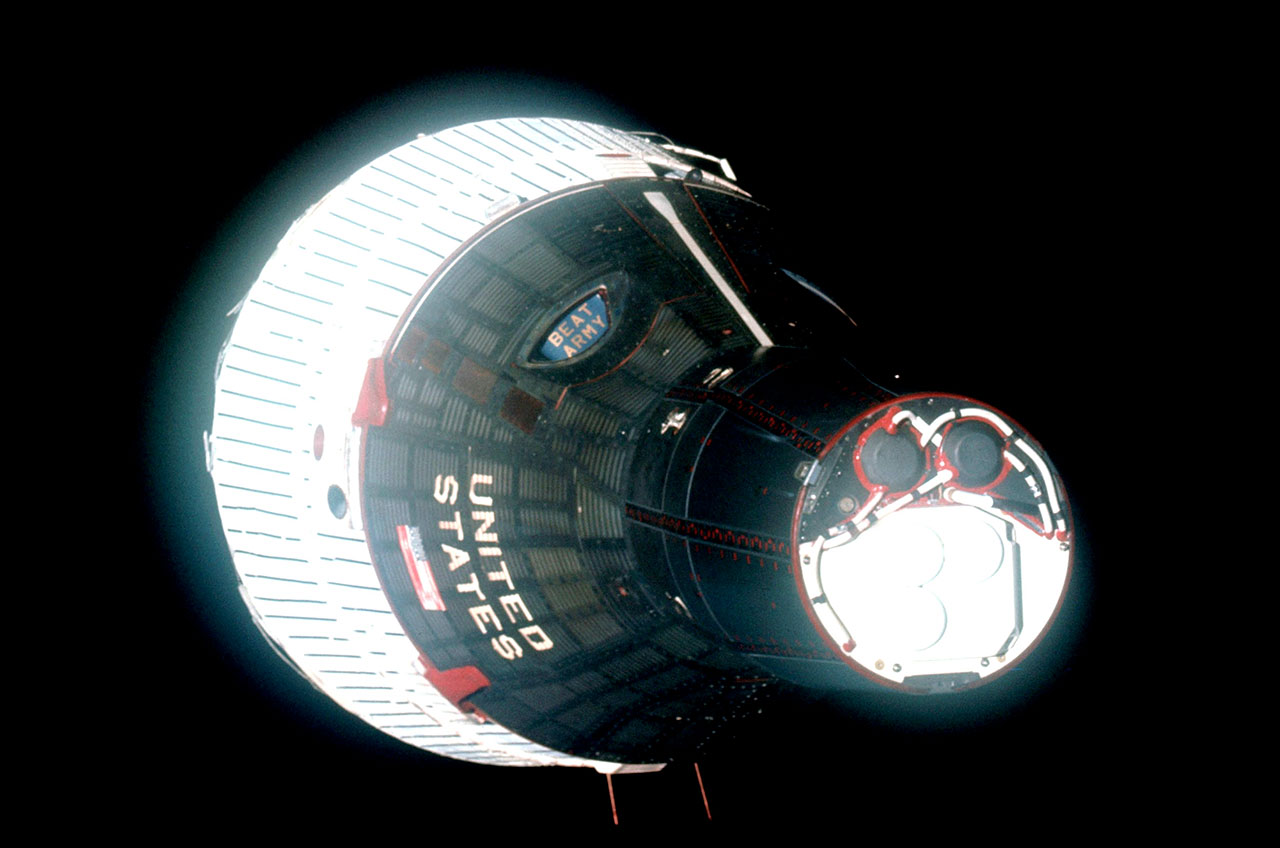Naval Academy's NASA-inspired uniforms extend Army-Navy Game's space history
This is a giant leap beyond Gemini astronauts holding up signs rooting for their service to win.

A long-lasting rivalry that first reached outer space almost 60 years ago is bringing NASA's history onto the football field as part of this year's Army-Navy Game.
First played in 1890, the classic matchup between the Army Black Knights of the U.S. Military Academy in West Point, New York and the Navy Midshipmen of the U.S. Naval Academy in Annapolis, Maryland will highlight one of the service's contributions to the U.S. space program when the two teams meet at the 50-yard line on Saturday (Dec. 11).
As revealed last month, Navy Athletics and Under Armor created an astronaut-themed uniform for the Midshipmen to wear during the 123rd playing of the Army-Navy Game at Lincoln Financial Field in Philadelphia. CBS will air the game on national television beginning at 3 p.m. EST (2000 GMT).
Related: US Naval Academy unveils NASA-inspired football uniforms ahead of Army-Navy game
"I'm excited in what it represents," said Ken Niumatalolo, Midshipmen head coach, in a call with reporters. "We have more astronauts than any other school, which is obviously a pretty prestigious honor."
Fifty-four Naval Academy graduates have gone on to become NASA astronauts, beginning with Alan Shepard (Class of 1945), the first American to fly into space. Kayla Barron (Class of 2010), the academy's most recent astronaut alum, returned from her first mission, a 176-day stay on the International Space Station, in May and Nicole Mann (Class of 1999) is now in orbit aboard the complex.
Wally Schirra (1946) and Tom Stafford (1952) became the first two Naval Academy graduates to fly into space together in 1965. Their mission, Gemini 6A, launched after that year's game ended in a tie, but only because the flight was delayed for more than a month after a planned docking target was destroyed in a launch failure. Instead, Schirra and Stafford achieved the world's first rendezvous with another crewed spacecraft, Gemini 7, which had fellow academy graduate Jim Lovell (1952) and U.S. Military Academy alum Frank Borman on board.
Breaking space news, the latest updates on rocket launches, skywatching events and more!
With two spaceships within sight of each other, Schirra and Stafford held up a sign in their window that read "Beat Army." After landing, the two presented the sign to the academy's museum in Annapolis.

The uniforms that the Midshipmen will wear on Saturday pay tribute to that history and the past six decades of Navy and NASA interaction through their design.
The Naval Academy Athletic Association and Under Armour worked with NASA to use the space agency's "meatball" insignia on the players' right shoulders. That, coupled with the U.S. flag on the opposite arm, the use of the Helvetica font for the players' numbers and the overall white color of the garments is intended to evoke the look of a NASA spacesuit.
The NASA astronaut symbol — a five-pointed star with three trailing rays passing through a halo — appears on the uniform's gloves, the pants' side panels and on the helmet. The latter also features hand-crafted paintings of Bruce McCandless (1958) performing the world's first untethered spacewalk while testing the Manned Maneuvering Unit outside of the space shuttle in 1984.
The helmet also displays the NASA "worm" logo as McCandless and many other shuttle-era Naval Academy alumni wore while as astronauts.
The players' cleats are all white to mimic moon boots with shiny dots representing stars. The socks are royal blue with a red Navy wordmark inside of the border of a NASA worm patch.
"As somebody who loves space and who studies space, this one has got me super excited. It is my favorite uniform that we have had since I have been here," said Midshipmen raider Nicolas Straw, who joined the team as a linebacker in 2019. "The helmets are so well done. The hand painting is exceptional and has such fine attention to detail."
The Army Black Knights' uniforms honor the 1st Armored Division during World War II. Brigadier General Shane Reeves, dean of the U.S. Military Academy, took issue with the Navy's homage to NASA in a good spirited video featuring NASA astronaut and West Point graduate Drew Morgan.
"You know Navy's desperate if they are claiming independent federal agencies to put on their uniform," said Reeves in the social media spot. "Alright Drew, you've been to space, so help me out. I'm trying to figure out why Navy is so fascinated with space. Are there oceans on the moon?"
"Nope, Buzz Aldrin, West Point class of 1951, already checked that out," replies Morgan.
Aldrin also had an answer to Schirra's and Stafford's prank aboard Gemini 6A. A year later in 1966, Aldrin took a hand-sewn "Go Army, Beat Navy" sign with him on one of his spacewalks. The Army had beaten Navy that year, 20 to 7.
Aldrin held onto that sign until this year, when he sold it at a Sotheby's auction for $27,720.
Follow collectSPACE.com on Facebook and on Twitter at @collectSPACE. Copyright 2022 collectSPACE.com. All rights reserved.

Robert Pearlman is a space historian, journalist and the founder and editor of collectSPACE.com, a daily news publication and community devoted to space history with a particular focus on how and where space exploration intersects with pop culture. Pearlman is also a contributing writer for Space.com and co-author of "Space Stations: The Art, Science, and Reality of Working in Space” published by Smithsonian Books in 2018.
In 2009, he was inducted into the U.S. Space Camp Hall of Fame in Huntsville, Alabama. In 2021, he was honored by the American Astronautical Society with the Ordway Award for Sustained Excellence in Spaceflight History. In 2023, the National Space Club Florida Committee recognized Pearlman with the Kolcum News and Communications Award for excellence in telling the space story along the Space Coast and throughout the world.



